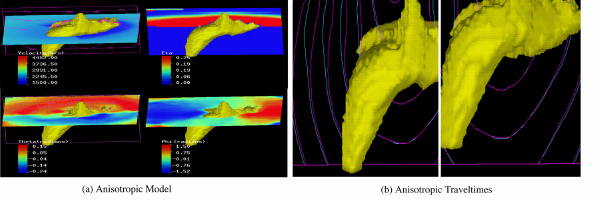Raytracing
For a source at x s and receiver at x r, if we denote the traveltime or phase from x s to x r by φ ( x r ;x s ), and the Amplitude decay by A ( x r ;x s ), we can then write Equation 147 in space-time and Equation 148 in frequency.
 | (147) |
 | (148) |
Substituting into the wave equation in Equation 149, we get Equation 150.
 | (149) |
![i!2 (r )2 --1-- + i![2rA r + A ] A ei! = 0:
v2(x)](book223x.png) | (150) |
Equating coefficients of powers of iω to zero yields the Eikonal equation, Equation 151 and the transport equation, Equation 152.
 | (151) |
 | (152) |
Simultaneous solution of Equation 151 and Equation 152 provides the traveltimes and amplitudes necessary to approximate the Green's function in an efficient manner. While not straightforward, the Eikonal equation as specified here can be solved by finite differences and/or the method of characteristics. The method of characteristics is usually referred to by the more traditional raytracing label.
The method of characteristics is so called because it solves the Eikonal equation along rays by simultaneously solving Equation 153 and Equation 154.
 | (153) |
 | (154) |
In this case, σ typically represents arc length along the characteristic or ray, and x ( σ ) is the position of the ray vector at the distance σ from the initial position of the ray. The process is usually initialized by setting x (0) = x s to the initial source position and setting, as shown in Equation 155.
 | (155) |
Once x ( σ ) is known, the desired traveltime is computed by integrating along the characteristic curve in Equation 156.
 | (156) |
- Introduction
- Seismic Modeling
- Primary Concerns
- Three Earth Models
- Seismic Acquisition: The Basic Idea
- Why Model?
- Waves and Wavefields
- The Scalar Wave Equations
- Stress-Strain Equations
- Algorithms
- Variational Formulation and Finite Elements
- Finite Differences
- Model Boundaries
- Fourier Based Methods
- A Word About Sources
- Huygens Principle and Integral Methods
- Raytracing
- Raytrace Modeling
- Zero Offset Modeling
- History
- Zero Offset Migration Algorithms
- Exploding Reflector Examples
- Prestack Migration
- Prestack Migration Examples
- Data Acquisition
- Migration Summary
- Isotropic Velocity Analysis
- Anisotropic Velocity Analysis
- Case Studies
- Course Summary



